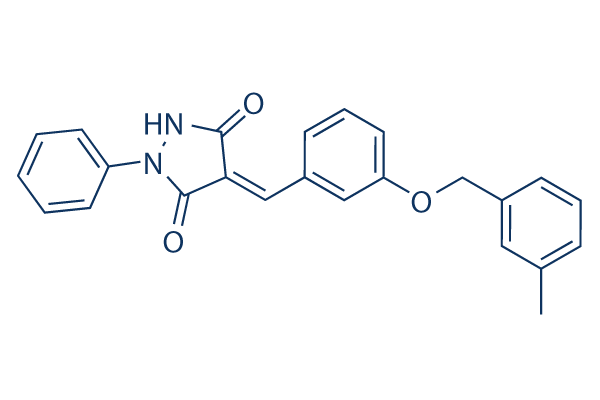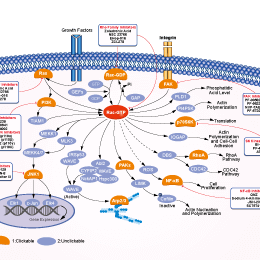
- Bioactive Compounds
- By Signaling Pathways
- PI3K/Akt/mTOR
- Epigenetics
- Methylation
- Immunology & Inflammation
- Protein Tyrosine Kinase
- Angiogenesis
- Apoptosis
- Autophagy
- ER stress & UPR
- JAK/STAT
- MAPK
- Cytoskeletal Signaling
- Cell Cycle
- TGF-beta/Smad
- DNA Damage/DNA Repair
- Compound Libraries
- Popular Compound Libraries
- Customize Library
- Clinical and FDA-approved Related
- Bioactive Compound Libraries
- Inhibitor Related
- Natural Product Related
- Metabolism Related
- Cell Death Related
- By Signaling Pathway
- By Disease
- Anti-infection and Antiviral Related
- Neuronal and Immunology Related
- Fragment and Covalent Related
- FDA-approved Drug Library
- FDA-approved & Passed Phase I Drug Library
- Preclinical/Clinical Compound Library
- Bioactive Compound Library-I
- Bioactive Compound Library-Ⅱ
- Kinase Inhibitor Library
- Express-Pick Library
- Natural Product Library
- Human Endogenous Metabolite Compound Library
- Alkaloid Compound LibraryNew
- Angiogenesis Related compound Library
- Anti-Aging Compound Library
- Anti-alzheimer Disease Compound Library
- Antibiotics compound Library
- Anti-cancer Compound Library
- Anti-cancer Compound Library-Ⅱ
- Anti-cancer Metabolism Compound Library
- Anti-Cardiovascular Disease Compound Library
- Anti-diabetic Compound Library
- Anti-infection Compound Library
- Antioxidant Compound Library
- Anti-parasitic Compound Library
- Antiviral Compound Library
- Apoptosis Compound Library
- Autophagy Compound Library
- Calcium Channel Blocker LibraryNew
- Cambridge Cancer Compound Library
- Carbohydrate Metabolism Compound LibraryNew
- Cell Cycle compound library
- CNS-Penetrant Compound Library
- Covalent Inhibitor Library
- Cytokine Inhibitor LibraryNew
- Cytoskeletal Signaling Pathway Compound Library
- DNA Damage/DNA Repair compound Library
- Drug-like Compound Library
- Endoplasmic Reticulum Stress Compound Library
- Epigenetics Compound Library
- Exosome Secretion Related Compound LibraryNew
- FDA-approved Anticancer Drug LibraryNew
- Ferroptosis Compound Library
- Flavonoid Compound Library
- Fragment Library
- Glutamine Metabolism Compound Library
- Glycolysis Compound Library
- GPCR Compound Library
- Gut Microbial Metabolite Library
- HIF-1 Signaling Pathway Compound Library
- Highly Selective Inhibitor Library
- Histone modification compound library
- HTS Library for Drug Discovery
- Human Hormone Related Compound LibraryNew
- Human Transcription Factor Compound LibraryNew
- Immunology/Inflammation Compound Library
- Inhibitor Library
- Ion Channel Ligand Library
- JAK/STAT compound library
- Lipid Metabolism Compound LibraryNew
- Macrocyclic Compound Library
- MAPK Inhibitor Library
- Medicine Food Homology Compound Library
- Metabolism Compound Library
- Methylation Compound Library
- Mouse Metabolite Compound LibraryNew
- Natural Organic Compound Library
- Neuronal Signaling Compound Library
- NF-κB Signaling Compound Library
- Nucleoside Analogue Library
- Obesity Compound Library
- Oxidative Stress Compound LibraryNew
- Plant Extract Library
- Phenotypic Screening Library
- PI3K/Akt Inhibitor Library
- Protease Inhibitor Library
- Protein-protein Interaction Inhibitor Library
- Pyroptosis Compound Library
- Small Molecule Immuno-Oncology Compound Library
- Mitochondria-Targeted Compound LibraryNew
- Stem Cell Differentiation Compound LibraryNew
- Stem Cell Signaling Compound Library
- Natural Phenol Compound LibraryNew
- Natural Terpenoid Compound LibraryNew
- TGF-beta/Smad compound library
- Traditional Chinese Medicine Library
- Tyrosine Kinase Inhibitor Library
- Ubiquitination Compound Library
-
Cherry Picking
You can personalize your library with chemicals from within Selleck's inventory. Build the right library for your research endeavors by choosing from compounds in all of our available libraries.
Please contact us at [email protected] to customize your library.
You could select:
- Antibodies
- Bioreagents
- qPCR
- 2x SYBR Green qPCR Master Mix
- 2x SYBR Green qPCR Master Mix(Low ROX)
- 2x SYBR Green qPCR Master Mix(High ROX)
- Protein Assay
- Protein A/G Magnetic Beads for IP
- Anti-Flag magnetic beads
- Anti-Flag Affinity Gel
- Anti-Myc magnetic beads
- Anti-HA magnetic beads
- Magnetic Separator
- Poly DYKDDDDK Tag Peptide lyophilized powder
- Protease Inhibitor Cocktail
- Protease Inhibitor Cocktail (EDTA-Free, 100X in DMSO)
- Phosphatase Inhibitor Cocktail (2 Tubes, 100X)
- Cell Biology
- Cell Counting Kit-8 (CCK-8)
- Animal Experiment
- Mouse Direct PCR Kit (For Genotyping)
- New Products
- Contact Us
Y16
Y16 is an inhibitor of G-protein-coupled Rho GEFs. It blocks the binding of LARG, a DBL-family Rho guanine nucleotide exchange factor, with Rho (Kd = 80 nM).

Y16 Chemical Structure
CAS No. 429653-73-6
Purity & Quality Control
Batch:
S675201
DMSO]39 mg/mL]false]Water]Insoluble]false]Ethanol]Insoluble]false
Purity:
99.24%
99.24
Y16 Related Products
| Related Targets | Cdc42-subclass Rac Rho-subclass | Click to Expand |
|---|---|---|
| Related Products | NSC 23766 trihydrochloride CCG-1423 EHop-016 ML141 EHT 1864 2HCl ZCL278 MBQ-167 CCG-203971 Rhosin hydrochloride CID44216842 | Click to Expand |
| Related Compound Libraries | Kinase Inhibitor Library PI3K/Akt Inhibitor Library MAPK Inhibitor Library DNA Damage/DNA Repair compound Library Cell Cycle compound library | Click to Expand |
Signaling Pathway
Biological Activity
| Description | Y16 is an inhibitor of G-protein-coupled Rho GEFs. It blocks the binding of LARG, a DBL-family Rho guanine nucleotide exchange factor, with Rho (Kd = 80 nM). | |
|---|---|---|
| Targets |
|
| In vitro | ||||
| In vitro | Y16 binds to the junction site of the DH-PH domains of LARG with a ∼80 nM Kd and suppresses LARG catalyzed RhoA activation dose dependently. It is active in blocking the interaction of LARG and related G-protein–coupled Rho GEFs with RhoA without a detectable effect on other DBL family Rho GEFs, Rho effectors, or a RhoGAP. In cells, Y16 selectively inhibits serum-induced RhoA activity and RhoA-mediated signaling, effects that can be rescued by a constitutively active RhoA or ROCK mutant. By suppressing RhoA activity, Y16 inhibits mammary sphere formation of MCF7 breast cancer cells but does not affect the nontransforming MCF10A cells. Y16 works synergistically with Rhosin/G04, a Rho GTPase activation site inhibitor, in inhibiting LARG–RhoA interaction, RhoA activation, and RhoA-mediated signaling functions. Y16 effectively inhibits the growth, migration, and invasion activities of breast cancer cells[1]. |
|||
|---|---|---|---|---|
| Cell Research | Cell lines | PC-3 cells | ||
| Concentrations | 10 μM | |||
| Incubation Time | 36 h | |||
| Method | PC-3 cells were quiesced in RPMI1640 containing 0.5% FBS for 24 hr. Cells were then trypsinized, resuspended in RPMI1640 containing 0.5% FBS, and counted. A total of 2.5 × 104 cells were loaded into the upper chamber. The lower chamber was filled with RPMI1640 supplemented with 10% FCS. A13 (10 μM), A2 (10 μM), Y16 (10 μM), or DMSO was added both in the upper and lower chambers. The concentration of DMSO in the medium was 0.1% for all experimental conditions. After a 36 hr incubation period, the cell suspension was aspirated, and the membranes were fixed in 70% ethanol at -20℃ for 20 min. Cells that had attached but not migrated were removed, the membranes were rinsed in water, and migrated cells on the underside of the membrane were visualized with staining in 2% crystal violet. Cells were counted on three independent transwell membranes using a light microscope. |
|||
Chemical Information & Solubility
| Molecular Weight | 384.43 | Formula | C24H20N2O3 |
| CAS No. | 429653-73-6 | SDF | -- |
| Smiles | CC1=CC(=CC=C1)COC2=CC=CC(=C2)C=C3C(=O)NN(C3=O)C4=CC=CC=C4 | ||
| Storage (From the date of receipt) | 3 years -20°C powder | ||
|
In vitro |
DMSO : 39 mg/mL ( (101.44 mM) Moisture-absorbing DMSO reduces solubility. Please use fresh DMSO.) Water : Insoluble Ethanol : Insoluble |
Molecular Weight Calculator |
|
In vivo Add solvents to the product individually and in order. |
In vivo Formulation Calculator |
||||
Preparing Stock Solutions
Molarity Calculator
In vivo Formulation Calculator (Clear solution)
Step 1: Enter information below (Recommended: An additional animal making an allowance for loss during the experiment)
mg/kg
g
μL
Step 2: Enter the in vivo formulation (This is only the calculator, not formulation. Please contact us first if there is no in vivo formulation at the solubility Section.)
% DMSO
%
% Tween 80
% ddH2O
%DMSO
%
Calculation results:
Working concentration: mg/ml;
Method for preparing DMSO master liquid: mg drug pre-dissolved in μL DMSO ( Master liquid concentration mg/mL, Please contact us first if the concentration exceeds the DMSO solubility of the batch of drug. )
Method for preparing in vivo formulation: Take μL DMSO master liquid, next addμL PEG300, mix and clarify, next addμL Tween 80, mix and clarify, next add μL ddH2O, mix and clarify.
Method for preparing in vivo formulation: Take μL DMSO master liquid, next add μL Corn oil, mix and clarify.
Note: 1. Please make sure the liquid is clear before adding the next solvent.
2. Be sure to add the solvent(s) in order. You must ensure that the solution obtained, in the previous addition, is a clear solution before proceeding to add the next solvent. Physical methods such
as vortex, ultrasound or hot water bath can be used to aid dissolving.
Tech Support
Answers to questions you may have can be found in the inhibitor handling instructions. Topics include how to prepare stock solutions, how to store inhibitors, and issues that need special attention for cell-based assays and animal experiments.
Tel: +1-832-582-8158 Ext:3
If you have any other enquiries, please leave a message.
* Indicates a Required Field
Tags: buy Y16 | Y16 supplier | purchase Y16 | Y16 cost | Y16 manufacturer | order Y16 | Y16 distributor







































